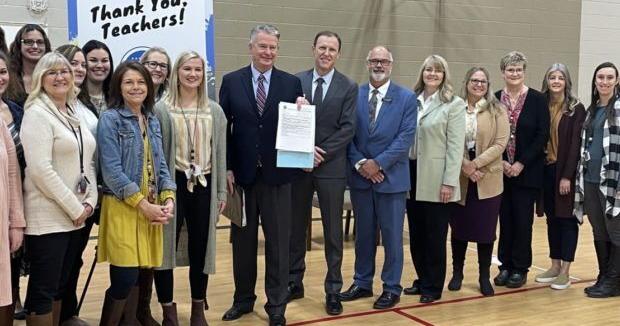Schools hesitant to join Idaho’s health insurance plan with incoming funding boost – Idaho Press

Idaho lawmakers voted to send an additional $105 million annually to K-12 schools in hopes of improving employees’ health insurance. But some schools are hesitant to switch over to the state’s comparatively low-premium, high-benefit insurance plan for fear that the state funding won’t cover the costs.
Proponents have touted the funding increase as a “game changer,” though schools and the law’s legislative sponsor alike say the $105 million won’t be enough to bring insurance benefits for K-12 staff up to par with the $12,500 spent on other state employees (schools currently get $8,400 per state-funded employee).
“We’ve been trying for so long to get on the state plan, and it would be really, really cool if we could,” said Nampa School District Finance Director Randy Dewey. “But at the present time, it just financially doesn’t make sense.”
Gov. Brad Little proposed the benefits boost in his January State of the State address, and has signed into law a policy bill and a spending bill to execute the change.
Those bills add the $105 million in annual state spending, tack on $75.5 million in federal one-time money to help cover the costs of switching onto the state plan and cut a $17.9 million leadership premium program as a tradeoff.
But on the bottom line, districts will be “a little bit short” of the annual funding they need to spend as much on their employees as state agencies do, said Rep. Rod Furniss, R-Rigby, who sponsored the increases that sailed through 2022 Legislature.
Rod Furniss
That’s for several reasons.
One is that the $105 million figure was calculated through the state’s arcane funding formula for schools, so only state-covered positions will be funded, as Little’s budget chief Alex Adams confirmed to EdNews last month. That doesn’t cover staff positions that districts pay for with other sources — whether from property tax levies, other state funds or federal cash.
The Nampa district, for example, will be over $600,000 short of what it would cost to pay for the state’s plan year to year, Dewey told EdNews this week.
Another reason is that state funding may be earmarked for school employee health insurance, but schools can spend that at their discretion. Furniss said some lawmakers have overestimated how much of this money schools are using on other expenses, but even the extra money won’t have strings attached to it. The money is “discretionary,” so schools can use it on whatever purposes they choose.
As administrators take stock of their budgets, it’s too soon for some to tell whether they’ll be able to switch over to the state’s plan, or whether they’ll put the annual funding boost into lowering out-of-pocket costs for their employees.
After Little ceremoniously signed the policy bill increasing insurance funding into law in front of Melba Elementary School’s student body, Melba’s superintendent said she wasn’t sure whether the money would be enough to join the state plan.
“If we can swing it, that obviously would be my preference, because it would benefit all staff. Their premium would be greatly reduced, and their deductible would be greatly reduced,” Superintendent Sherry Ann Adams told EdNews. “But I can’t do it at the cost of cutting programs.”
If they don’t switch to the state’s plan, rural districts can face added challenges. Districts like Melba, which only employs around 100 people, have considerably less bargaining power with insurance companies, Ann Adams said, but she hopes having the state plan as an option will help in negotiations.
Making the switch
Districts also cite another reason for hesitating to switch on to the state plan: the $75.5 million of one-time money is not enough to cover the upfront costs.
To join the state plan, enrollees have to pay into a “high risk claims pool,” a shared pot that helps the state pay for expensive and unexpected medical procedures and bills.
Do you LOVE local news? Get Local News Headlines in your inbox daily.
Thanks! You’ll start receiving
the headlines tomorrow!
Furniss, the legislative sponsor for the increases, is a career insurance salesman and sits on the Your Health Idaho board, which deals with state insurance issues. He maintains that school districts will get enough federal money to cover the upfront costs and switch over to the state plan. Plus, he says the state’s high-risk pool is $50 million overfunded now, and he hopes that could be used to offset the costs for schools.
Still, many are proceeding with caution.
Dewey estimates the state funding will cover just over half of the $5.9 million upfront cost of joining the state plan, though Furniss disputes claims that districts won’t be able to cover those costs, pointing to differences in how the $75.5 million will be divided up.
Dewey remains optimistic about the change.
“Even if we put all this (annual state) money in our own plan, we’re gonna have a much better plan for our teachers,” he said.
After meeting with several school administrators, Furniss anticipates most districts won’t switch to the state plan for another year; they have two years to do so, before a deadline to spend federal aid.
From the outset, advocates of the policy switch have never said all districts will move onto the state plan.
“The governor’s goal is to provide better health insurance coverage to school employees; in some cases that may mean joining the state plan, in other cases that will mean providing coverage through other carriers, but in all cases, the governor’s goal is to lower the premiums or deductibles school employees face,” Alex Adams told EdNews by email in early February.
‘A good tradeoff’
While cutting a $17.9 million leadership premium for experienced teachers will still leave schools with a net funding boost, some are disappointed with the cut. Especially if teachers can’t get on the state’s plan in return.
“For that to just be gone for nothing makes it seem like some kind of big scam to just get rid of the leadership premium money,” said Nampa Education Association President Brian Coffey.
In Nampa, the district uses the $3,000 premiums to recruit so-called hard-to-fill special education jobs. The district will have to find another way to make up the difference to prevent those teachers from taking a salary hit, said Dewey.
Furniss has called the cut “a good tradeoff,” and he made an early campaign promise, of sorts, in a Wednesday interview with EdNews.
He said he’ll look to “fix” the shortfall in state spending, so it covers all staffers, by pushing legislation to increase ongoing state spending on employee health insurance next year if he’s reelected.
In the meantime, he hopes to allay administrators’ concerns, amid confusion about how much money districts will get, and how it will be divided up.
“I’ve had meetings with 90 superintendents. They’ve all interpreted this differently,” Furniss said.
As districts get a better understanding of their budget pictures, there could be an increase in schools moving onto the state plan, Furniss anticipates.
“They’re seeing if we’re legit. No one’s ever given them this much money before and they’re just afraid. You know, this is the biggest increase in state budget that they’ve ever seen. And they’ve never trusted the money we’ve given them before and you know, I don’t blame them for being skeptical. I don’t blame them one bit.”





